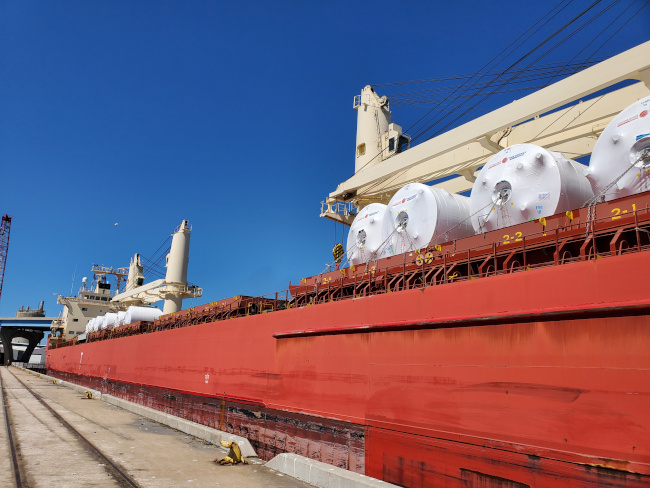Port of Milwaukee Sees Opportunity for Growth Amid Project Cargo Diversification

Last week, it is was a 1,110-tonne per hour ship unloader. Yesterday, a set of superstructures for a 37-meter-long superyacht. Port Milwaukee is seeing more diversity in its project cargo movements and that, according to Maria Cartier, market development manager at the port, is great news.
“From the port’s perspective, cargo diversification provides more opportunity for growth. Years ago, we handled a lot of coal and that market went away. Today we focus on diversification, and that is good for our future viability,” Cartier said at Breakbulk Americas 2022 in Houston.
Port Milwaukee handles a growing mix of non-containerized general cargo including brewery tanks, mining equipment, forest products, transformers, heavy machinery, manufacturing equipment, steel products and other project cargoes.
The superyacht components were handled by Federal Marine Terminals and arrived at Milwaukee’s Jones Island facility from the Port of Antwerp-Bruges on 26 September onboard Fednav’s Federal Cedar.
Cartier said the port can enhance supply chain capacity for many types of cargo. “We move about 2.5 million tonnes of bulk and breakbulk commodities each year,” said Cartier.
 Last week’s cargo movements included a massive ship loader, delivered to Port Milwaukee’s future Agricultural Maritime Export Facility. The $40 million facility is the largest port capital project in decades. It will be funded in part by a US$15.9 million Port Infrastructure Development Program grant, and is being constructed on the west side of Jones Island, part of the port’s South Harbor Tract facilities.
Last week’s cargo movements included a massive ship loader, delivered to Port Milwaukee’s future Agricultural Maritime Export Facility. The $40 million facility is the largest port capital project in decades. It will be funded in part by a US$15.9 million Port Infrastructure Development Program grant, and is being constructed on the west side of Jones Island, part of the port’s South Harbor Tract facilities.
While the Made in America ship loader travelled more than 1,500 miles by barge from New Orleans, Louisiana, up the Mississippi and Illinois Rivers to Jones Island, additional project components have arrived by vessel, barge and truck.
This new facility will be the first foray into bulk for the DeLong Co., Inc., the largest US exporter of containerized agricultural products. The Agricultural Maritime Export Facility project is expected to be completed and operational by March 2023.
It will be one of the first terminals on the seaway system to handle varied agricultural commodities via truck, rail and international vessel. Cargoes will initially include Dried Distillers Grains with Solubles, or DDGs, an animal feed supplement derived as a by-product of ethanol. Other grains such as corn and soybeans are forthcoming, according to Cartier, who said the port’s growing bulk cargo volumes offer potential for bulker bags as well.
DeLong’s operation will open doors for Wisconsin's maritime and agricultural economies to enter and expand into international markets. It is part of Port Milwaukee’s new 50-year capital asset renewal plan, which provides a strategic roadmap for investment and maintenance of docks, rail, warehousing, storage, and other port assets. “Together, these capital improvements support growth in every type of port cargo,” said Cartier.
It has been an interesting year at the port, especially for project cargo. “I’ve seen brewery tanks, turbines used in paper manufacturing industry, these yacht parts and this ship loader, all in a very short period of time,” said Cartier.
She attributes the port’s burgeoning breakbulk business to exceptional facilities, experienced terminal operators, dedicated MPV services and the availability of port-owned cranes, including mobile crawler cranes that can lift up to 300 tonnes.
Such assets help the port serve virtually any type of general cargo vessel.
Port Milwaukee is exhibiting at Breakbulk Americas 2022, running this week, 27-29 September. It is not too late to get your tickets! Click below for registration details.
